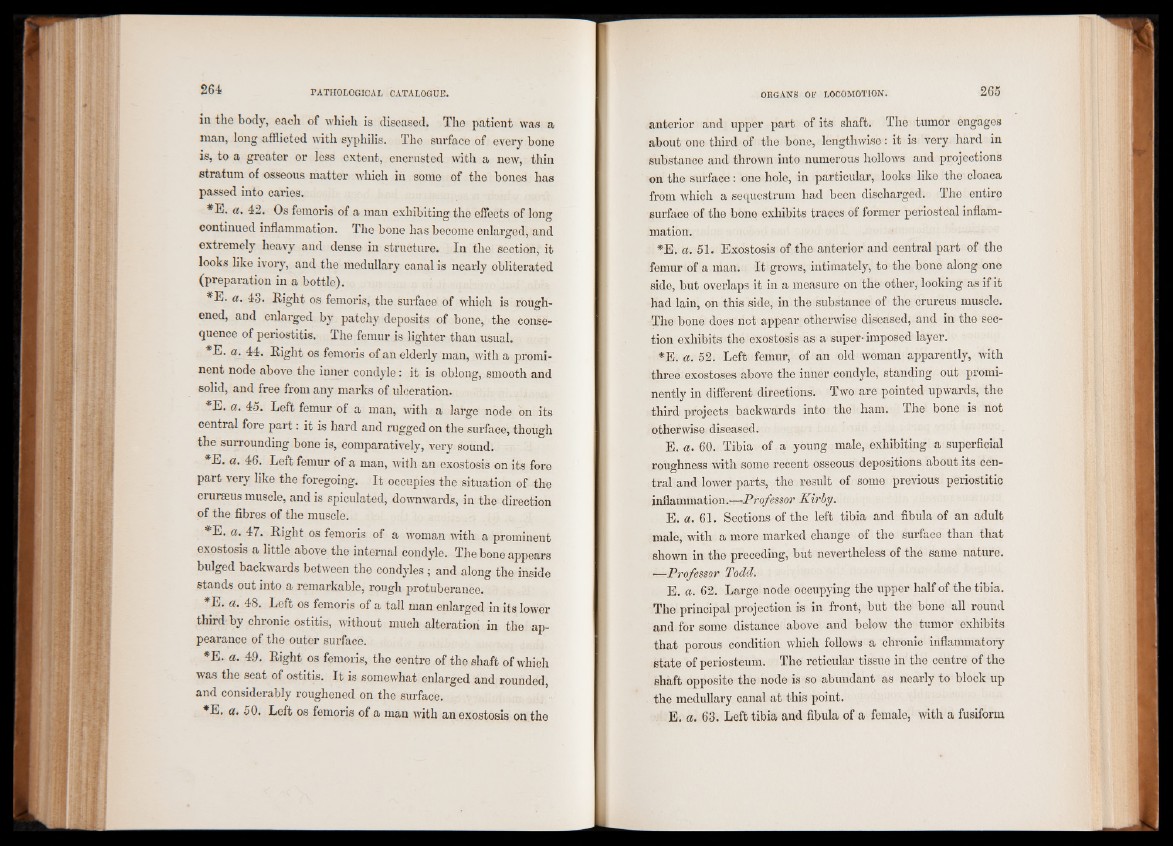
in the body, each of which is diseased. The patient was a
man, long afflicted with syphilis. The surface of every bone
is, to a greater or less extent, encrusted with a new, thin
stratum of osseous matter which in some of the bones has
passed into caries.
#E. a. 42. Os femoris of a man exhibiting the effects of long
continued inflammation. The bone has become enlarged, and
extremely heavy and dense in structure. In the section, it
looks like ivory, and the medullary canal is nearly obliterated
(preparation in a bottle).
#E. a. 43. Eight os femoris, the surface of which is roughened,
and enlarged by patchy deposits of bone, the consequence
of periostitis. The femur is lighter than usual.
*E. a. 44. Eight os femoris of an elderly man, with a prominent
node above the inner condyle: it is oblong, smooth and
solid, and free from any marks of ulceration.
E. a. 45. Left femur of a man, with a large node on its
central fore part: it is hard and rugged on the surface, though
the surrounding bone is, comparatively, very sound.
*E- «• 46. Left femur of a man, with an exostosis on its fore
part very like the foregoing. It occupies the situation of the
crurseus muscle, and is spiculated, downwards, in the direction
of the fibres of the muscle.
*E. a. 47. Eight os femoris of a woman with a prominent
exostosis a little above the internal condyle. The bone appears
bulged backwards between the condyles; and along the inside
stands out into a remarkable, rough protuberance.
*E. a. 48. Left os femoris of a tall man enlarged in its lower
third-by chronic ostitis, without much alteration in the appearance
of the outer surface.
*E. a. 49. Eight os femoris, the centre of the shaft of which
was the seat of ostitis. It is somewhat enlarged and rounded,
and considerably roughened on the surface.
*E. &» 50. Left os femoris of a man with an exostosis on the
anterior and upper pai*t of its shaft. The tumor engages
about one third of the bone, lengthwise: it is very hard in
substance and thrown into numerous hollows and projections
on the surface: one hole, in particular, looks like the cloaca
from which a sequestrum had been discharged. The entire
surface of the bone exhibits traces of former periosteal inflammation.
*E. a. 51. Exostosis of the anterior and central part of the
femur of a man. It grows, intimately, to the bone along one
side, but overlaps it in a measure on the other, looking as if it
had lain, on this side, in the substance of the crureus muscle.
The bone does not appear otherwise diseased, and in the section
exhibits the exostosis as a super-imposed layer.
*E. a. 52. Left femur, of an old woman apparently, with
three exostoses above the inner condyle, standing out prominently
in different directions. Two are pointed upwards, the
third projects backwards into the ham. The bone is not
otherwise diseased.
E. a. 60. Tibia of a young male, exhibiting a superficial
roughness with some recent osseous depositions about its central
and lower parts, the result of some previous periostitic
inflammation.—Professor Kirby.
E. a. 61. Sections of the left tibia and fibula of an adult
male, with a more marked change of the surface than that
shown in the preceding, but nevertheless of the same nature.
—Professor Todd.
E. a. 62. Large node occupying the upper half of the tibia.
The principal projection is in front, but the bone all round
and for some distance above and below the tumor exhibits
that porous condition which follows a chronic inflammatory
state of periosteum. The reticular tissue in the centre of the
shaft opposite the node is so abundant as nearly to block up
the medullary canal at this point.
E. a. 63. Left tibia and fibula of a female, with a fusiform